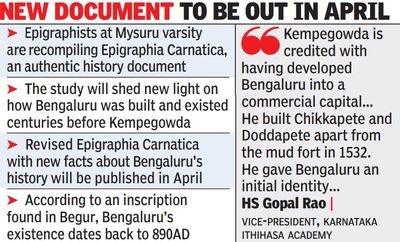Bengaluru :
Epigraphists at the University of Mysore are close to unveiling facts about Bengaluru’s founding fathers. And, the story predates Kempegowda, who is believed to have founded the city.
The team is recompiling Epigraphia Carnatica -considered an authentic history document -which will shed new light on how Bengaluru was built and how it existed with its present name centuries before Kempegowda.
“The recompilation is going on in full swing. We are aiming at publishing revised volumes about Bengaluru by April 2018,” said MG Manjunath, organizing editor of Epigraphia Carnatica’s revised volumes.
Among the information to be added to the document are the chapters about an inscription found in Begur on the city outskirts, according to which Bengaluru’s existence dates back to 890AD and the period before it. The inscription found in 1952 at Nageswara Temple in Begur says: “Bengaluru kaalagadalli Nagaththarana maga Buttanasetty saththam.” (Nagaththara’s son Buttanasetty was killed in the Bengaluru battle). Nagaththara was a feudatory ruler under Gangas, who flour ished in the ninth century , and the inscription is believed to have been written in 890AD.
Another piece of evidence to show Bengaluru had been built much before the time of Kempegowda (1510 to 1570AD) is an inscription on the wall of Someshwara Temple near Madiwala Lake. It reads that the Hoysala king Veera Ballala donated a piece of paddy land to the temple in 1218AD and mentions the temple was in Bengaluru.
“These are known facts and it has already been established that Bengaluru existed much before Kempegowda,” said HS Gopal Rao, vice-president, Karnataka Ithihasa Academy , and a wellknown epigraphist. Efforts are on to recom pile disparate historical facts into an authentic document and the revised volumes of Epigraphia Carnatica related to Bengaluru districts will be published,” Gopal Rao added.
Rao, however, said Kempe gowda’s contribution to the city’s development cannot be denied. “Kempegowda is credited with having developed Bengaluru into a commercial capital of Yalahanka Naadu. He built commercial hubs like Chikkapete and Doddapete apart from the mud fort that was built in 1532. He gave Bengaluru an initial identity, thanks to the temples and the four iconic towers among other monuments he constructed,” Rao said.
The original Epigraphia Carnatica complied and published in 1905 by British historian and archaeologist B L Rice contained 12 volumes.While it was based on over 9,000 inscriptions found till then, there was a supplementary volume based on the findings at a later stage. The supplementary volume had more information about Bengaluru, but it was not included in the main volume, which went out of print in 1950. Subsequently, over 2,000 more inscriptions were found, and Kuvempu Kannada Study Centre of UoM took up the task of recompiling Epigraphia Carnatica with inclusion of the supplementary volume and later findings.
Deverakonda Reddy, president of Karnataka Itihasa Academy, was tasked with compiling two volumes about Bengaluru in 2005. But he could not complete the project for want of support from the university in terms of resources and manpower, and he surrendered it in 2013. “The work has been fast-tracked now. I hope the revised volumes are published early next year,” said Reddy.
source: http://www.timesofindia.indiatimes.com / The Times of India / News> City News> Bangalore News / by Shivshankar / TNN / October 28th, 2017
